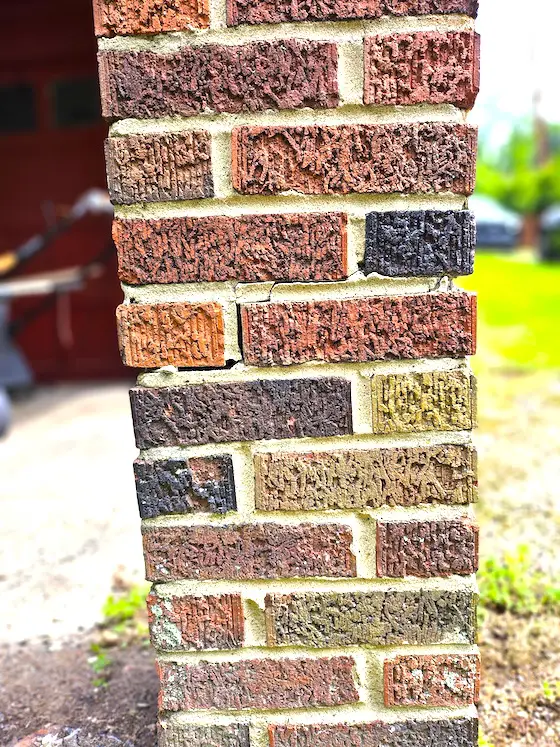Cracks – Pinpoint the Cause Before Repairing

This crack in a small brick pier indicates a semi-serious structural problem. Don’t ignore things like this. Copyright 2024 Tim Carter
Crack Repair - Pinpoint the Cause Before Repairing
Houses are just like you and me. As they age, they develop wrinkles or cracks. Some people don’t like wrinkled skin. Just as Ponce de León was searching for the fountain of youth, many people look for products to recreate their smooth teenage skin. Home centers sell tons of crack-filling products each year that homeowners use in and around their homes. Cosmetic manufacturers may sell a similar amount, for all I know.
I have first-hand experience with the magic one can employ to disguise wrinkles on faces and cracks in houses. Nearly twenty years ago, I was a judge on the reality TV show The Mansion. Each day, I sat in a chair, and a professional makeup woman touched me up before we started to record.
One day, we were talking about spackling cracks in her old plaster walls. After I told her how to bridge the cracks using mesh tape, she told me about a special cosmetic liquid that does the same thing for facial wrinkles. “Oh, I use an amazing clear liquid on a person’s wrinkles before I apply the foundation. The liquid dries fast and bridges all but the deepest wrinkles. This liquid makes older skin look as smooth as silk.”
It just so happens that years later, there are clear products you can use to fill cracks in many things around your home. I’ve had great luck with certain caulks that dry crystal clear. I used some on the rear window of my pickup truck cap to seal a leak. It’s held up well now for two years.
Masonry Cracks
But what about cracks in concrete slabs, brick, stone, concrete or concrete block foundations, and any other exterior parts of your home? If the cracks could talk, what would they say to you? I can tell you they’d have several different stories about why they suddenly appear.
Here’s an example. About a month ago Louis reached out to me using the Ask Tim page of my www.AsktheBuilder.com website. Louis lives in Pittsburgh, PA. He sent a great photo of an exterior brick column at his home. The column was no longer perfectly straight and had a crack in it. Think what a small stick would look like if you tried to snap it in half.
Louis provided me with a very important piece of information to help diagnose what was causing the crack. He mentioned two things. First, there was a crack that ran from the ceiling to the floor in a room addition that was built in 1980. He mentioned he noticed the cracks at the same time not too long ago.
Think about that data point. All was well for a little over forty years! Pittsburgh’s topography is quite hilly. The cracks might be caused by land movement. A broken sewer pipe could be eroding the ground under the room addition. There are all sorts of things that could be going on. My advice to Louis is that he needs to pinpoint the cause of the cracks before he wastes time repairing them, only to find them reappear in weeks or a month.
Concrete Shrinkage Cracks
Some cracks around your home are minor and are to be expected. Every year, I receive quite a few emails from homeowners like you who are steaming mad about cracks in their new concrete driveways, sidewalks, and patios. They feel the new concrete should be free of all blemishes.
The truth is concrete shrinks 1/16th of an inch for every ten horizontal feet that’s poured. Did you know that? This shrinkage creates a tension force that tears the concrete apart just as you might rip a piece of paper in two. Professional concrete masons know all about this tension force. This is why they use tools or cut control joints in concrete slabs. The joints are an attempt to control where the crack will develop. A straight line looks so much better than a jagged crack in a concrete slab.
Control Where Cracks Happen in Concrete
Control joint depth is critical. The minimum depth is 1/4th the thickness of the slab. Most tools used to create joints will not cut that deep. It’s best to saw cut control joints in concrete.
If you want to ensure the cracks in concrete stay small, be sure to install reinforcing steel. I’ve had great success over the years using 1/2-inch rebar placed on 2-foot centers in both directions, much like graph paper looks. I ensure at least 1.5 inches of concrete under the steel bars.
Keep a Journal
If you see a crack start to develop, you should start to keep a journal. Take a pencil or permanent marker and make a line across the crack. Use a ruler with millimeter markings and measure the width of the crack. Take readings once a month to see if the crack is getting wider. Be sure to record the date you take each measurement. Note any other strange things that might be happening in or around your home that are not ordinary. A professional will use this data to help diagnose the cause of the crack.
Hygroscopic Cracks Tough to Control
Realize some cracks in your home come and go as the seasons change. If your home is framed with lumber, the seasonal change in humidity can cause much of the lumber in your home to swell and then contract as the humidity drops in cooler weather. There’s not much you can do to prevent this movement.
Column 1566